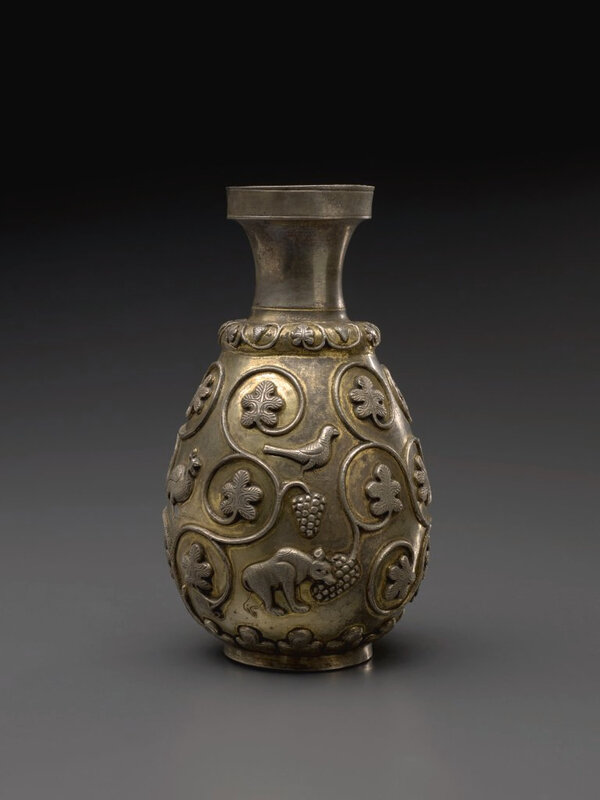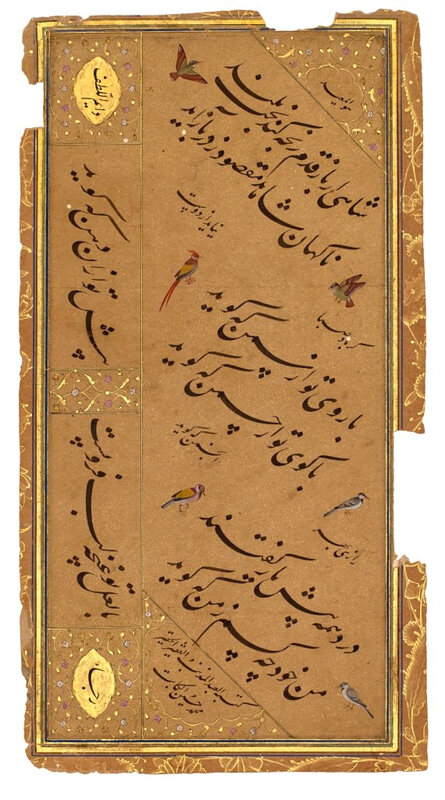High Museum presents rarely displayed Persian art
ATLANTA, GA.- This winter, the High Museum of Art presents “Bestowing Beauty: Masterpieces from Persian Lands” (Dec. 12, 2020-April 18, 2021), an exhibition of nearly 100 works exemplifying the rich artistic traditions of Iranian civilization from the 6th to the 19th century.
Organized by the Museum of Fine Arts, Houston, “Bestowing Beauty” features works rarely publicly displayed from one of the most significant private collections of Persian art, the Hossein Afshar Collection. The works span a range of media, including carpets, textiles, manuscripts, paintings, ceramics, lacquer, metalwork and jeweled objects. Highlights include exquisite miniature paintings from the Shahnama, the Iranian national epic; a range of historically significant ceramics; precious inlaid metal wares; finely woven silk fabrics; and a monumental silk carpet from the height of Safavid carpet production.
“The magnificent range, as well as the historical significance, of the works featured in this exhibition is simply extraordinary,” said Rand Suffolk, Nancy and Holcombe T. Green, Jr., director of the High. “We are honored to bring such an important collection of Persian art to Atlanta and look forward to sharing it with our audience."
Monica Obniski, the High’s curator of decorative arts and design, said, “We are pleased to present High visitors with stunning works from several centuries of Persian cultural production. This rich artistic tradition demonstrates universal themes of humanity and reminds us that art serves to connect people across cultures — an urgent appeal, especially today, when we need reminders that we are more similar than dissimilar.”
The objects on display reveal extraordinary stories, filled with experiences, ideas and emotions shared by all peoples. The artworks are grouped within the exhibition into sections focused on faith and piety, love and longing, kingship and authority, banquets and battles, and earth and nature.
Jar, Iran, sixth century. Silver-gilt; hammered, repoussé, chased, and mercury gilded, the Hossein Afshar Collection at the Museum of Fine Arts, Houston.
Faith and Piety
Faith and piety are expressed in exquisitely penned Qur’an manuscripts produced across Islamic lands. The primary role of calligraphy in transmitting the word of God is paramount, but calligraphers also copied a variety of texts in addition to the Qur’an. Calligraphers enjoyed the highest status among artists, as reflected in the careful adornment of their tools.
Star Tile, Iran, Kashan or Takht-i Sulayman, possibly AH 690/1291–1292. Stonepaste; luster and cobalt painted on opaque white glaze, the Hossein Afshar Collection at the Museum of Fine Arts, Houston.
Love and Longing
Love and longing are among the most celebrated themes in art around the world. The universal desire for the deepest form of human connection — also a metaphor for one’s yearning for divine love — finds profound expression in Persian poetry. A familiar subject in Persian poetry and art is that of the rose and the nightingale (gul u bulbul). The rose symbolizes the beloved, who has thorns and can be cruel, and the nightingale, the lover, who sings endlessly of his longing. This depiction of earthly devotion can be extrapolated to represent divine love and the soul’s search for a union with God. Earthly images of love and longing in this section include a pair of tightly embracing lovers on a slim lacquer pen case.
“Kay Khusrau Flees from Turan to Iran and Crosses the River Jaihun with Giv and Farangis”.Folio from a Shahnama of Firdausi, Iran, Shiraz, AH 741–742/1341. Opaque watercolor, ink, and gold on paper, the Hossein Afshar Collection at the Museum of Fine Arts, Houston.
Kingship and Authority, Banquets and Battles
Imagery of kingship and authority figures has remained prominent in illustrated manuscripts of the Shahnama, or Book of Kings, since the 14th century. The related theme of banquets and battles (bazm u razm) — quintessential aspects of Persian kingship — is very popular. A new image of authority reached an apex in 19th-century Iran under the Qajars. Persian court painters created individualized portraits of contemporary kings, princes and members of the ruling elite, capturing the political agendas, personalities and images of power that their patrons sought to embody. Wonderful examples of these portraits are a highlight of the exhibition.
Attributed to Aqa Mirak, Persian, active sixteenth century, Bookbinding, Iran, third quarter of the sixteenth century. Watercolor, gold-colored pigments, and lacquer on pasteboard, the Hossein Afshar Collection at the Museum of Fine Arts, Houston.
Earth and Nature
In the monotheistic traditions of Christianity, Judaism and Islam, the beauty of nature is a reminder of God as the giver of life. The garden is an earthly representation of this notion. A love for garden-like settings and the promise of spring and renewal pervade Persian culture. Representations of flowers, trees and flowing waters featured in this section’s artworks evoke the ancient idea of the garden as a symbol of paradise.

Mahmud Muzahhib’s Tyranny of a Teacher Is Better than the Love of a Father, folio from a Gulistan of Saʿdi, Uzbekistan, Bukhara (c. 1560), the Hossein Afshar Collection at the Museum of Fine Arts, Houston.
Exhibition Catalogue
“Bestowing Beauty: Masterpieces from Persian Lands — Selections from the Hossein Afshar Collection” (2019) is edited by Aimée Froom, curator at the Museum of Fine Arts, Houston, and published by the Museum of Fine Arts, Houston, and Yale University Press. The catalogue is available for purchase in the Museum shop and online.
Folio of Calligraphy, India, late sixteenth–early seventeenth century . Signed Muhammad Husayn al-Katib, Indian, active sixteenth century. Folio of Calligraphy, India, late sixteenth–early seventeenth century. Ink, opaque watercolor, and gold on paper, the Hossein Afshar Collection at the Museum of Fine Arts, Houston.

Dervish, Iran, late sixteenth–mid seventeenth century. Ink, opaque watercolor, and gold on paper, the Hossein Afshar Collection at the Museum of Fine Arts, Houston.

The “King Umberto II Polonaise” Carpet, Iran, probably Isfahan or Kashan, early seventeenth century. Silk pile and gilt-silver, foil-wrapped silk thread on a foundation (warp and weft) of cotton and silk, the Hossein Afshar Collection at the Museum of Fine Arts, Houston.

Embroidered Panel, Iran, seventeenth century. Velvet, cotton, and metal-wrapped thread, the Hossein Afshar Collection at the Museum of Fine Arts, Houston.

Inkwell, Pakistan, Sindh, eighteenth century. Steel; overlaid with gold (koftgari), the Hossein Afshar Collection at the Museum of Fine Arts, Houston.

Pear, Iran, nineteenth century. Steel; inlaid with gold, the Hossein Afshar Collection at the Museum of Fine Arts, Houston.

Mirror Case, Iran, probably Shiraz, mid-nineteenth century. Watercolor, gold-colored pigments, metallic particles, and lacquer on pasteboard, the Hossein Afshar Collection at the Museum of Fine Arts, Houston.

Nasir al-Din Shah, Iran, Tehran, ca. 1848. Opaque watercolor and graphite on paper, the Hossein Afshar Collection at the Museum of Fine Arts, Houston.

/https%3A%2F%2Fprofilepics.canalblog.com%2Fprofilepics%2F1%2F0%2F100183.jpg)
/https%3A%2F%2Fstorage.canalblog.com%2F03%2F02%2F119589%2F96711876_o.jpg)
/https%3A%2F%2Fstorage.canalblog.com%2F11%2F31%2F119589%2F94773502_o.jpg)
/https%3A%2F%2Fstorage.canalblog.com%2F20%2F83%2F119589%2F94772815_o.jpg)
/https%3A%2F%2Fstorage.canalblog.com%2F26%2F72%2F119589%2F75604929_o.jpg)
/https%3A%2F%2Fstorage.canalblog.com%2F59%2F60%2F119589%2F26458628_o.jpg)








/image%2F1371349%2F20240423%2Fob_b2fe42_telechargement-9.jpg)
/image%2F1371349%2F20240423%2Fob_af8bb4_telechargement-6.jpg)
/image%2F1371349%2F20240423%2Fob_b6c4a6_telechargement.jpg)
/image%2F1371349%2F20240423%2Fob_981d5f_h22891-l367411650-original.jpg)